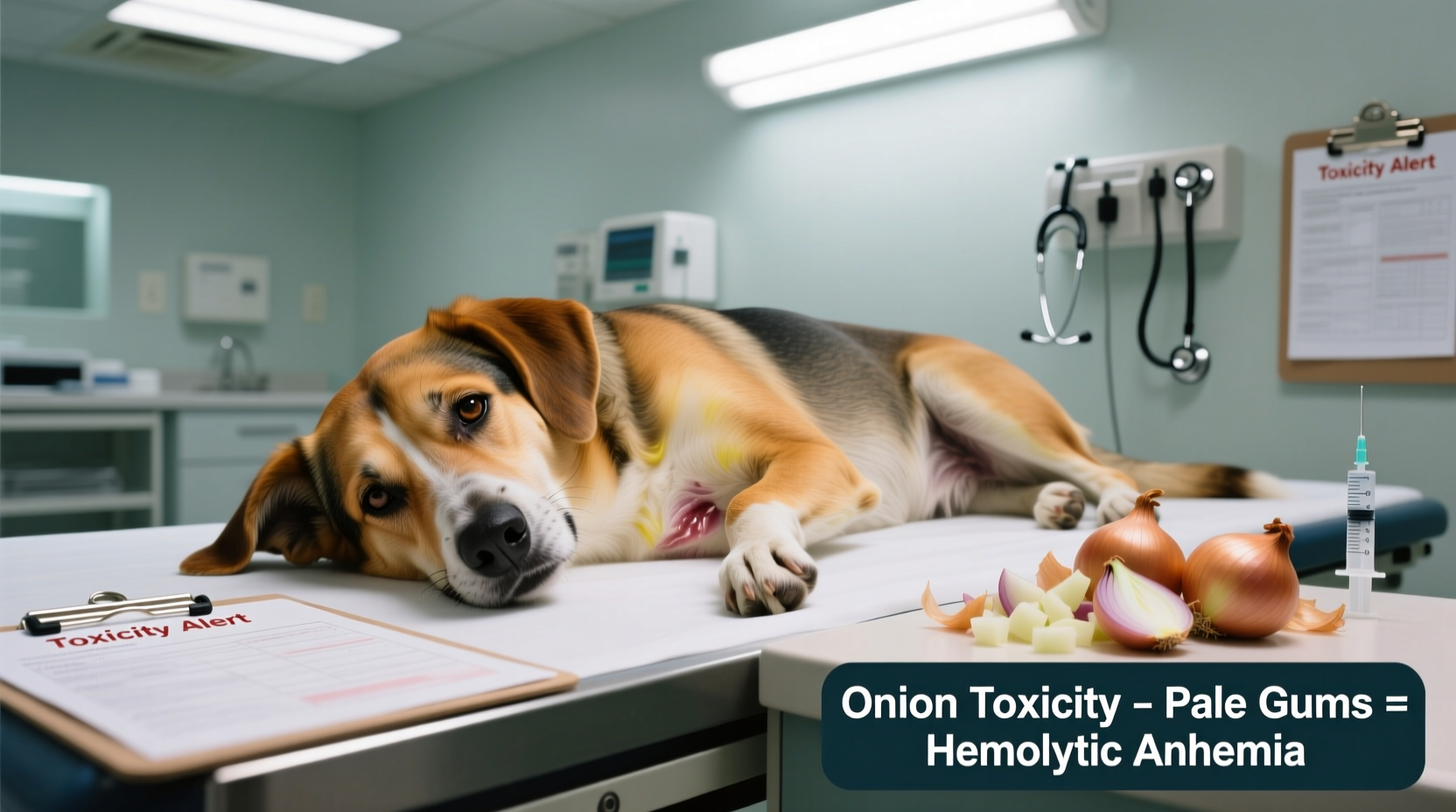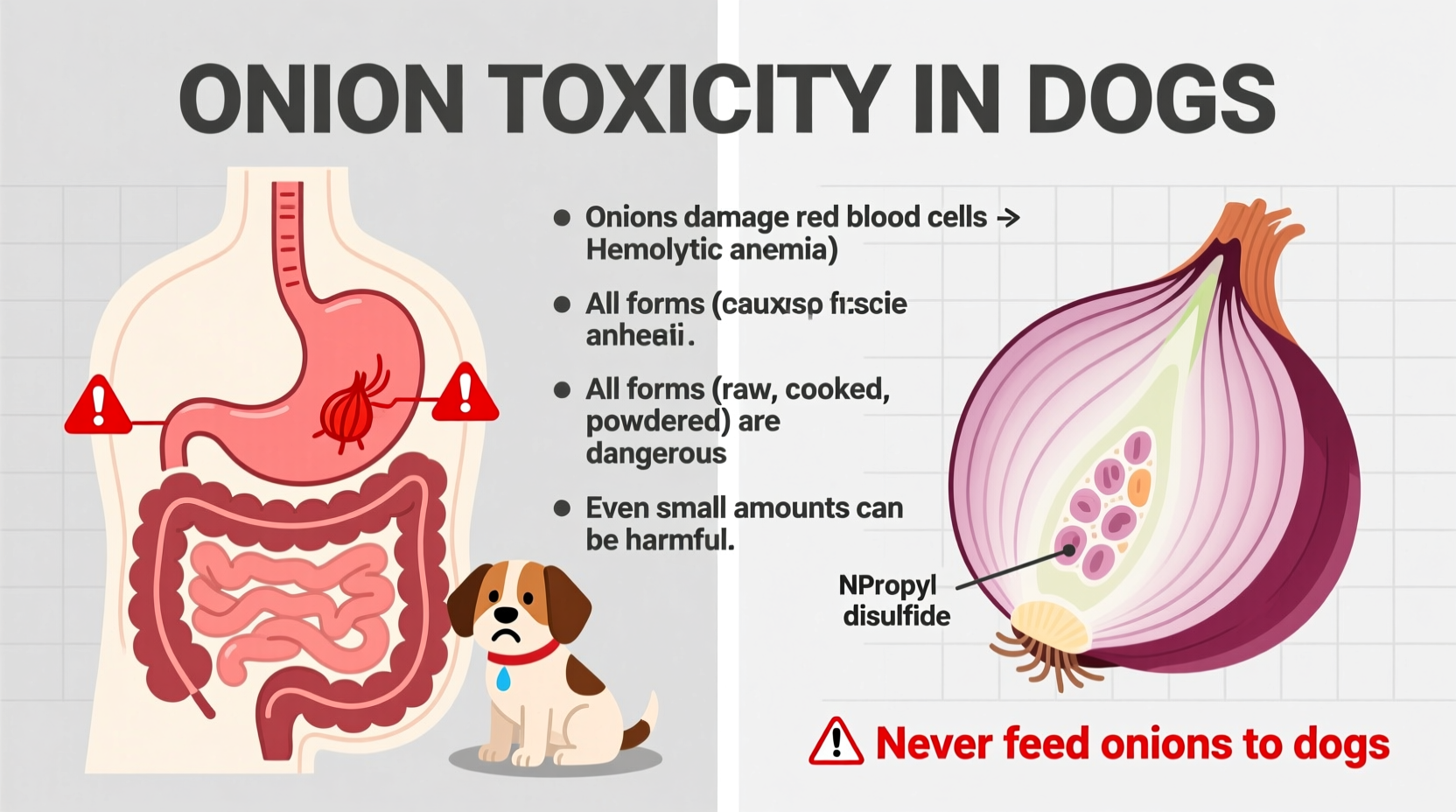Discovering your dog has eaten onions triggers immediate panic, and for good reason. This common kitchen ingredient poses a serious, potentially fatal risk to canine health that many pet owners don't recognize until it's too late. Understanding exactly what does onion do to dogs could save your pet's life.
Why Onions Are Dangerous for Dogs: The Science Behind the Toxicity
Onions contain a compound called N-propyl disulfide that attacks a dog's red blood cells, causing them to rupture in a process known as hemolysis. This leads to hemolytic anemia, where the body can't deliver sufficient oxygen to vital organs. Unlike humans, dogs lack the specific enzyme needed to safely process these sulfur compounds.
"The mechanism of onion toxicity in dogs involves oxidative damage to hemoglobin, forming Heinz bodies that make red blood cells fragile and prone to destruction," explains Dr. Jennifer Coates, DVM, veterinary advisor for PetMD. This process begins within hours of ingestion and continues for several days.
| Onion Form | Toxic Dose for 20lb Dog | Onset of Symptoms |
|---|---|---|
| Raw onion | 5-10g (about 1/4 small onion) | 24-48 hours |
| Cooked onion | Same toxicity as raw | 24-48 hours |
| Onion powder | Just 1/4 teaspoon | 24-72 hours |
| Onion soup mix | As little as 1 packet | 12-24 hours |
Symptom Timeline: What to Watch For After Onion Ingestion
Understanding the progression of onion toxicity helps pet owners recognize when emergency intervention is needed. The timeline varies based on the amount consumed and your dog's size and breed:
- 0-12 hours: Often no visible symptoms, though some dogs may experience mild stomach upset
- 12-24 hours: Initial signs appear including lethargy, decreased appetite, and possible vomiting
- 24-72 hours: Critical period where anemia develops - look for pale gums, rapid breathing, weakness
- 3-5 days: Severe cases show dark red or brown urine (hemoglobinuria) as damaged red blood cells are processed
- 5+ days: Without treatment, organ damage and potentially fatal complications can occur

Breed-Specific Vulnerabilities: Not All Dogs React the Same
While all dogs are susceptible to onion toxicity, certain breeds face higher risks due to genetic factors. Japanese breeds like Shiba Inus and Akita Inus have naturally lower levels of the enzyme needed to process onion compounds, making them particularly vulnerable.
"We've seen cases where a Shiba Inu developed severe anemia after consuming what would be a sub-toxic amount for a Labrador," notes Dr. Sarah Wooten, a certified veterinary journalist. "This breed-specific sensitivity means owners of Japanese breeds must be especially vigilant about preventing any onion exposure."
Immediate Action Plan: What to Do If Your Dog Eats Onions
Time is critical when dealing with onion ingestion. Follow these steps immediately:
- Contact your veterinarian or animal poison control (ASPCA Animal Poison Control: 888-426-4435) - do not wait for symptoms
- Document exactly what was consumed - type of onion, estimated amount, and time of ingestion
- Do NOT induce vomiting unless specifically instructed by a professional
- Bring packaging or remaining food to the vet appointment for identification
- Monitor for early symptoms while en route to the clinic
Professional treatment may include intravenous fluids, oxygen therapy, blood transfusions in severe cases, and medications to support red blood cell production. Early intervention significantly improves outcomes.
Preventing Onion Exposure: Practical Safety Measures
Prevention remains the most effective strategy for protecting your dog. Implement these practical measures:
- Store onions and garlic in cabinets inaccessible to curious dogs
- Dispose of onion scraps immediately in secured outdoor bins
- Read pet food and treat labels carefully for onion or garlic powder
- Train family members (especially children) about the dangers of sharing human food
- Be cautious with foods containing hidden onion derivatives like soups, gravies, and processed meats
Remember that all members of the Allium family - including garlic, leeks, chives, and shallots - pose similar risks to dogs. Garlic is actually more toxic than onions, with some studies suggesting it's five times more potent.
Common Misconceptions About Onions and Dogs
Several dangerous myths persist about onion toxicity in dogs:
- "Cooking destroys the toxic compounds" - False. Cooking doesn't reduce toxicity; it may even concentrate harmful compounds
- "Small amounts are safe" - Dangerous. Toxicity is cumulative, and even small repeated exposures can cause damage
- "My dog ate onions before with no issues" - Misleading. Some dogs show delayed reactions, and repeated exposure increases risk
- "Only raw onions are dangerous" - Incorrect. Powdered onion is actually more concentrated and dangerous
When considering what does onion do to dogs, remember that no amount is considered safe. The ASPCA Animal Poison Control Center reports consistent cases of onion toxicity year-round, with spikes during holiday seasons when table scraps are more commonly shared.
When to Seek Emergency Care
Don't hesitate to seek veterinary care if your dog has consumed onions. Warning signs requiring immediate attention include:
- Pale or white gums (press gently on gum line - color should return within 2 seconds)
- Extreme lethargy or weakness
- Rapid breathing or heart rate
- Dark red, brown, or orange urine
- Collapse or inability to stand
These symptoms indicate advanced hemolytic anemia that requires urgent medical intervention. Prompt treatment significantly improves recovery chances.
Long-Term Outlook After Onion Exposure
With timely veterinary care, most dogs recover fully from onion toxicity. The prognosis depends on several factors:
- Amount consumed relative to body weight
- Time elapsed before treatment began
- Breed-specific vulnerabilities
- Pre-existing health conditions
Dogs that receive treatment before severe anemia develops typically recover within 3-5 days. Those requiring blood transfusions may need several weeks for complete recovery as the body regenerates healthy red blood cells.











 浙公网安备
33010002000092号
浙公网安备
33010002000092号 浙B2-20120091-4
浙B2-20120091-4